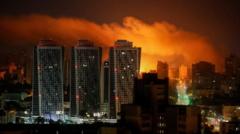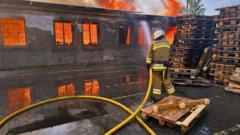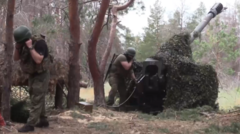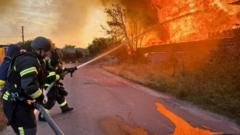Ukraine faces an unprecedented wave of drone and missile strikes, primarily launched by Russia, significantly impacting civilian safety and morale. Despite resilience, many Ukrainians are grappling with fear, compounded by the destructive capabilities of advanced drones.
Escalating Drone Warfare in Ukraine: A New Phase of Fear and Resilience

Escalating Drone Warfare in Ukraine: A New Phase of Fear and Resilience
The intensifying drone assaults on Ukrainian cities are amplifying fear and diminishing morale as the conflict escalates.
As the war in Ukraine intensifies, the past few months have seen a surge in drone and missile attacks, striking at the heart of cities including Kyiv. Citizens are now familiar with the chilling sound of swarms of Russian drones, a stark contrast to the initial use of these aerial weapons. This renewed wave of warfare, characterized by vast coordinated strikes, is inflicting deep psychological scars on the population.
Last night, Kyiv endured another harrowing bombardment, reminiscent of previous assaults. Residents like Katya described the physical sensations of fear as their homes trembled from nearby explosions, forcing many to seek refuge in bomb shelters after years of avoiding them. The emotional toll is profound, illustrated by an 11-year-old boy's newfound understanding of mortality during a recent attack.
The United Nations reported a record number of civilian casualties in June, with 232 people killed and over 1,300 injured, underscoring the relentless nature of these strikes. While many casualties are near the front lines, civilians in distant cities face comparable dangers. According to Danielle Bell from HRMMU, the surge in long-distance attacks is catalyzing widespread devastation across Ukraine.
Strategically modified Shahed drones have increased in altitude and range, creating new targets for the air defense systems of Ukraine. Experts are closely analyzing the tracking of these drone swarms, with many serving as decoys to counteract air defenses. Despite being less sophisticated than other military hardware, these drones exploit the critical disparity in resources between Russia and Ukraine, complicating the defensive measures that Ukraine can deploy.
Recent analyses indicate a troubling trend in the frequency of strikes, with more than 5,000 drone incidents reported in June alone—a record for the conflict. Some analysts predict that Russian forces could soon have the capacity to unleash over 1,000 drones and missiles within a single night, placing immense strain on Ukrainian defenses.
Experts warn that without a decisive strategy to combat the escalating drone threat, Ukraine may face substantial challenges in the near future. The sheer volume of strikes could overwhelm the country’s air defenses. In response, Ukraine's President Zelensky has been vocal in seeking increased support from allies to bolster the nation's defense capabilities.
As the situation continues to unfold, the necessity for a robust international response, including the provision of advanced air defense systems, has never been clearer. The British government recently announced a significant agreement to deliver more than 5,000 air defense missiles to Ukraine, showcasing the need for such strategic collaborations in the ongoing conflict.























